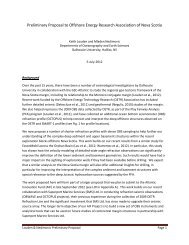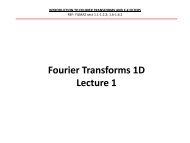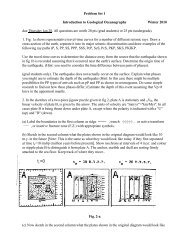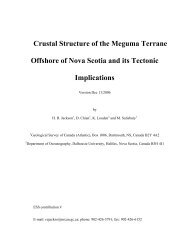Traveltime tomography inversion Traveltime tomography inversion
Traveltime tomography inversion Traveltime tomography inversion
Traveltime tomography inversion Traveltime tomography inversion
You also want an ePaper? Increase the reach of your titles
YUMPU automatically turns print PDFs into web optimized ePapers that Google loves.
<strong>Traveltime</strong> <strong>tomography</strong> <strong>inversion</strong><br />
Using:<br />
First arrival refraction <strong>tomography</strong> using FAST<br />
Joint refraction and single reflector <strong>tomography</strong><br />
using TOMO2D<br />
louise.watremez@dal.ca<br />
<strong>Traveltime</strong> <strong>tomography</strong> <strong>inversion</strong><br />
Preparation for the modeling<br />
Modeling the seismic arrival times with FAST and<br />
Tomo2D<br />
Quantitative and qualitative resolutions of the<br />
preferred model, or “How to present your<br />
<strong>tomography</strong> results?”<br />
Preparation for the modeling<br />
Data picking<br />
Estimation of the picking uncertainties<br />
Initial velocity model
Preparation for the modeling<br />
Data picking<br />
Estimation of the picking uncertainties<br />
Initial velocity model<br />
Preparation for the modeling - Picking<br />
Example of data<br />
Preparation for the modeling - Picking<br />
Picking of the first arrivals (red)
Preparation for the modeling - Picking<br />
Picking of the first arrivals (red)<br />
and Moho wide-angle reflections (green)<br />
Preparation for the modeling<br />
Data picking<br />
Estimation of the picking uncertainties<br />
Initial velocity model<br />
Preparation for the modeling - Uncertainties<br />
Small offsets (2-4 km) - signal to noise ratio very low<br />
Minimum picking uncertainty<br />
20 ms
Preparation for the modeling - Uncertainties<br />
>10 km offsets - signal to noise ratio a little bit higher<br />
Still low picking uncertainty<br />
20 ms<br />
Preparation for the modeling - Uncertainties<br />
Variation of the signal to noise ratio with the offset<br />
Need to adapt the picking uncertainty<br />
500 ms<br />
Preparation for the modeling - Uncertainties<br />
Variation of the signal to noise ratio with the offset<br />
Need to adapt the picking uncertainty<br />
500 ms
Preparation for the modeling - Uncertainties<br />
The signal to noise ratio of the data around a pick varies<br />
depending on the offset<br />
It also varies with the instrument, the seafloor conditions<br />
(tidal noise, currents, geology...).<br />
Different solutions to assign uncertainty values to your<br />
picks:<br />
- “by hand”<br />
- offset dependent (unc = a*offset + b)<br />
- signal to noise ratio dependent (see Zelt and Forsyth,<br />
1994)<br />
Preparation for the modeling<br />
Data picking<br />
Estimation of the picking uncertainties<br />
Initial velocity model<br />
Preparation for the modeling - Initial velocity model<br />
As simple as possible<br />
If possible: no velocity jumps<br />
Use available a-priori information
Modeling with FAST (Zelt and Barton, 1998)<br />
Model parameterization:<br />
• 2D velocity model parameterized as a uniform grid; Sources and<br />
receivers anywhere in the model; Different grids for forward and<br />
inverse problems<br />
Forward problem:<br />
• <strong>Traveltime</strong>s and raypaths calculated by solving the eikonal equation<br />
by finite differencing<br />
Inverse problem:<br />
• Iterative application of a sparse least squares regularized <strong>inversion</strong><br />
(LSQR variant of conjugate gradient method); Top part of the model<br />
can be "frozen" during <strong>inversion</strong><br />
Goal:<br />
• Minimum structure velocity model that satisfies chosen normalized<br />
chi-square test (model includes only structure required to fit the data<br />
according to its noise level)<br />
FAST (Zelt and Barton, 1998)<br />
Model parameterization:<br />
• 2D velocity model parameterized as a uniform grid; Sources and<br />
receivers anywhere in the model; Different grids for forward and<br />
inverse problems<br />
Forward problem:<br />
• <strong>Traveltime</strong>s and raypaths calculated by solving the eikonal equation<br />
by finite differencing<br />
Inverse problem:<br />
• Iterative application of a sparse least squares regularized <strong>inversion</strong><br />
(LSQR variant of conjugate gradient method); Top part of the model<br />
can be "frozen" during <strong>inversion</strong><br />
Goal:<br />
• Minimum structure velocity model that satisfies chosen normalized<br />
chi-square test (model includes only structure required to fit the data<br />
according to its noise level)<br />
FAST - Model parameterization<br />
Grid size of the file with the model = grid size for the<br />
forward modeling.<br />
The grid size for the forward modeling controls:<br />
- The accuracy of the synthetic traveltimes and ray paths<br />
- The computing time for the forward problem<br />
Need to find a good balance<br />
The grid size for the inverse model controls:<br />
- The resolution<br />
- The number of unknowns (velocities in cells) and thus,<br />
the stability of the model<br />
Need to find a good balance too<br />
PARAMETRIC STUDIES !
FAST (Zelt and Barton, 1998)<br />
Model parameterization:<br />
• 2D velocity model parameterized as a uniform grid; Sources and<br />
receivers anywhere in the model; Different grids for forward and<br />
inverse problems<br />
Forward problem:<br />
• <strong>Traveltime</strong>s and raypaths calculated by solving the eikonal equation<br />
by finite differencing<br />
Inverse problem:<br />
• Iterative application of a sparse least squares regularized <strong>inversion</strong><br />
(LSQR variant of conjugate gradient method); Top part of the model<br />
can be "frozen" during <strong>inversion</strong><br />
Goal:<br />
• Minimum structure velocity model that satisfies chosen normalized<br />
chi-square test (model includes only structure required to fit the data<br />
according to its noise level)<br />
FAST - Forward problem<br />
2 parameter files:<br />
f.in and r.in to control the finite differences computing<br />
and calculation of the ray paths.<br />
f.in: parameters for FD, position of sources (OBSs for<br />
marine and shots for land experiments)<br />
r.in: parameters for ray paths computation<br />
FD will look for the shortest traveltime across the grid<br />
between the source and the receiver.<br />
RAY will compute the ray paths with the output of FD.<br />
FAST (Zelt and Barton, 1998)<br />
Model parameterization:<br />
• 2D velocity model parameterized as a uniform grid; Sources and<br />
receivers anywhere in the model; Different grids for forward and<br />
inverse problems<br />
Forward problem:<br />
• <strong>Traveltime</strong>s and raypaths calculated by solving the eikonal equation<br />
by finite differencing<br />
Inverse problem:<br />
• Iterative application of a sparse least squares regularized <strong>inversion</strong><br />
(LSQR variant of conjugate gradient method); Top part of the model<br />
can be "frozen" during <strong>inversion</strong><br />
Goal:<br />
• Minimum structure velocity model that satisfies chosen normalized<br />
chi-square test (model includes only structure required to fit the data<br />
according to its noise level)
FAST - Inverse problem<br />
2 parameter files:<br />
l.in and i.in to control the <strong>inversion</strong>.<br />
l.in: parameters for the lambda values behavior<br />
i.in: parameters for <strong>inversion</strong> (details in the documentation)<br />
FAST (Zelt and Barton, 1998)<br />
Parametric study for the<br />
choice of the lambda:<br />
- Run at least 10-15<br />
iterations with different<br />
values for !<br />
- Check that the " 2 is<br />
stable for the further<br />
iterations<br />
- Choose the ! which<br />
converges to " 2 around 1<br />
- !: the higher, the better<br />
(model smoother)<br />
Model parameterization:<br />
• 2D velocity model parameterized as a uniform grid; Sources and<br />
receivers anywhere in the model; Different grids for forward and<br />
inverse problems<br />
Forward problem:<br />
• <strong>Traveltime</strong>s and raypaths calculated by solving the eikonal equation<br />
by finite differencing<br />
Inverse problem:<br />
• Iterative application of a sparse least squares regularized <strong>inversion</strong><br />
(LSQR variant of conjugate gradient method); Top part of the model<br />
can be "frozen" during <strong>inversion</strong><br />
Goal:<br />
• Minimum structure velocity model that satisfies chosen normalized<br />
chi-square test (model includes only structure required to fit the data<br />
according to its noise level)<br />
FAST - Velocity model<br />
Final model using picks on the MCS data and Chian et al.<br />
velocities as a-priori information + layer stripping approach using<br />
the option for freezing the upper part of the model.
Modeling with TOMO2D (Korenaga et al., 2000)<br />
Model parameterization:<br />
• 2D velocity model parameterized as a sheared mesh; Mesh size<br />
variable laterally and with depth; velocity field is made continuous by<br />
using bilinear interpolation in each parallelogram-shaped cell;<br />
Receivers on the seafloor; Sources anywhere in the model<br />
• Reflector represented by an array of linear segments whose nodal<br />
spacing is independent of that used in the velocity grid; Nodes have<br />
one degree of freedom (move only vertically); Reflector depth is<br />
updated freely without changing adjacent velocity nodes<br />
Forward problem:<br />
• <strong>Traveltime</strong>s and raypaths calculated using a hybrid ray-tracing<br />
scheme based on the graph method and local ray-bending<br />
refinement<br />
Inverse problem:<br />
• Iterative application of a sparse least squares regularized <strong>inversion</strong><br />
(LSQR variant of conjugate gradient method)<br />
Goal:<br />
• Minimum structure velocity model and one floating reflection<br />
boundary that satisfy chosen normalized chi-square test<br />
TOMO2D (Korenaga et al., 2000)<br />
Model parameterization:<br />
• 2D velocity model parameterized as a sheared mesh; Mesh size<br />
variable laterally and with depth; velocity field is made continuous by<br />
using bilinear interpolation in each parallelogram-shaped cell;<br />
Receivers on the seafloor; Sources anywhere in the model<br />
• Reflector represented by an array of linear segments whose nodal<br />
spacing is independent of that used in the velocity grid; Nodes have<br />
one degree of freedom (move only vertically); Reflector depth is<br />
updated freely without changing adjacent velocity nodes<br />
Forward problem:<br />
• <strong>Traveltime</strong>s and raypaths calculated using a hybrid ray-tracing<br />
scheme based on the graph method and local ray-bending<br />
refinement<br />
Inverse problem:<br />
• Iterative application of a sparse least squares regularized <strong>inversion</strong><br />
(LSQR variant of conjugate gradient method)<br />
Goal:<br />
• Minimum structure velocity model and one floating reflection<br />
boundary that satisfy chosen normalized chi-square test<br />
Tomo2D - Model parameterization<br />
Korenaga et al., 2000<br />
Mesh size can vary along the model and with depth: allows to have a<br />
finer grid near the seafloor and coarser in depth where less structure<br />
variations are expected.<br />
Same mesh for the forward and the inverse problems.<br />
Created using gen_smesh - see documentation for all the options
TOMO2D (Korenaga et al., 2000)<br />
Model parameterization:<br />
• 2D velocity model parameterized as a sheared mesh; Mesh size<br />
variable laterally and with depth; velocity field is made continuous by<br />
using bilinear interpolation in each parallelogram-shaped cell;<br />
Receivers on the seafloor; Sources anywhere in the model<br />
• Reflector represented by an array of linear segments whose nodal<br />
spacing is independent of that used in the velocity grid; Nodes have<br />
one degree of freedom (move only vertically); Reflector depth is<br />
updated freely without changing adjacent velocity nodes<br />
Forward problem:<br />
• <strong>Traveltime</strong>s and raypaths calculated using a hybrid ray-tracing<br />
scheme based on the graph method and local ray-bending<br />
refinement<br />
Inverse problem:<br />
• Iterative application of a sparse least squares regularized <strong>inversion</strong><br />
(LSQR variant of conjugate gradient method)<br />
Goal:<br />
• Minimum structure velocity model and one floating reflection<br />
boundary that satisfy chosen normalized chi-square test<br />
Tomo2D - Forward problem<br />
Forward problem here is the ray tracing.<br />
Need to have it optimized before beginning the <strong>inversion</strong><br />
process.<br />
Ray-tracing (hybrid) = graph + ray-bending methods<br />
Hybrid travel-time computing is more accurate than with<br />
the finite difference method but much more demanding in<br />
computing-time.<br />
See “further readings”<br />
Parametric study using tt_forward (parameters in the -N<br />
option):<br />
- Run with extreme parameters (huge computing time but<br />
the most accurate)<br />
- Find a set the parameters which will give almost the<br />
same travel-times with the smallest computing time.<br />
TOMO2D (Korenaga et al., 2000)<br />
Model parameterization:<br />
• 2D velocity model parameterized as a sheared mesh; Mesh size<br />
variable laterally and with depth; velocity field is made continuous by<br />
using bilinear interpolation in each parallelogram-shaped cell;<br />
Receivers on the seafloor; Sources anywhere in the model<br />
• Reflector represented by an array of linear segments whose nodal<br />
spacing is independent of that used in the velocity grid; Nodes have<br />
one degree of freedom (move only vertically); Reflector depth is<br />
updated freely without changing adjacent velocity nodes<br />
Forward problem:<br />
• <strong>Traveltime</strong>s and raypaths calculated using a hybrid ray-tracing<br />
scheme based on the graph method and local ray-bending<br />
refinement<br />
Inverse problem:<br />
• Iterative application of a sparse least squares regularized <strong>inversion</strong><br />
(LSQR variant of conjugate gradient method)<br />
Goal:<br />
• Minimum structure velocity model and one floating reflection<br />
boundary that satisfy chosen normalized chi-square test
Tomo2D - Inverse problem<br />
As the inverse problem is to realize a joint <strong>inversion</strong> of the<br />
first arrivals and the wide-angle reflections arrivals, there<br />
are much more parameters to control the <strong>inversion</strong> with<br />
Tomo2D than with FAST.<br />
Parametric study using tt_inverse:<br />
- Use the ray-tracing parameters found with the tt_forward<br />
parametric study<br />
- It will actually be parametric studies<br />
- Important parameters to test are (see documentation for<br />
definitions): the correlation lengths, the smoothing and the<br />
depth kernel weighting factors.<br />
- Other parameter which can be useful: the damping<br />
(automatic one tends to be already very good)<br />
Tomo2D - Inverse problem<br />
Parametric studies: extremes<br />
vertical horizontal<br />
CL top = 3 km<br />
CL bot = 10 km<br />
CL top = 1 km<br />
CL bot = 5 km<br />
CL top = 10 km<br />
CL bot = 30 km<br />
vertical horizontal<br />
CL top = 3 km<br />
CL bot = 10 km<br />
Tomo2D - Inverse problem<br />
Parametric studies: extremes<br />
wsv = 1<br />
wsv = 50<br />
Correlation lengths for the<br />
velocity nodes<br />
Controls the wavelengths<br />
of the structures in the<br />
model.<br />
Higher CL will lead to<br />
smoother model.<br />
Parametric study to find<br />
details without overinterpreting<br />
the data.<br />
Weighting factors for the<br />
velocity smoothing<br />
Controls the smoothness<br />
of the model.<br />
Higher weighting factors<br />
will lead to smoother<br />
model.<br />
Parametric study to find<br />
details without creating<br />
artifacts along the ray<br />
paths.
Tomo2D - Inverse problem<br />
Parametric studies: extremes<br />
W = 0.001<br />
W = 100<br />
TOMO2D (Korenaga et al., 2000)<br />
Depth kernel weighting<br />
factor<br />
Controls the weight of the<br />
wide-angle arrival picks<br />
compared to the first<br />
arrival picks.<br />
A W higher than will tend<br />
to fit the wide-angle<br />
reflection arrival times in<br />
priority.<br />
A W lower than 1 will tend<br />
to fit the first arrivals in<br />
priority.<br />
Parametric study to find<br />
the balance to fit both set<br />
of arrivals.<br />
Model parameterization:<br />
• 2D velocity model parameterized as a sheared mesh; Mesh size<br />
variable laterally and with depth; velocity field is made continuous by<br />
using bilinear interpolation in each parallelogram-shaped cell;<br />
Receivers on the seafloor; Sources anywhere in the model<br />
• Reflector represented by an array of linear segments whose nodal<br />
spacing is independent of that used in the velocity grid; Nodes have<br />
one degree of freedom (move only vertically); Reflector depth is<br />
updated freely without changing adjacent velocity nodes<br />
Forward problem:<br />
• <strong>Traveltime</strong>s and raypaths calculated using a hybrid ray-tracing<br />
scheme based on the graph method and local ray-bending<br />
refinement<br />
Inverse problem:<br />
• Iterative application of a sparse least squares regularized <strong>inversion</strong><br />
(LSQR variant of conjugate gradient method)<br />
Goal:<br />
• Minimum structure velocity model and one floating reflection<br />
boundary that satisfy chosen normalized chi-square test<br />
Tomo2D - Velocity model<br />
Final model using Chian et al. (2001) and Gerlings et al. (2011)<br />
velocities as a-priori information + parametric studies
Model’s quality and resolution<br />
Statistics: " 2 , RMS and N<br />
Constrained areas:<br />
Masked model,<br />
Ray-tracing figures,<br />
DWS<br />
Fits:<br />
Residuals diagram,<br />
Fits on the data<br />
Qualitative resolution:<br />
Checkerboard tests<br />
Quantitative resolution:<br />
Monte Carlo analysis<br />
Model’s quality and resolution<br />
Statistics: " 2 , RMS and N<br />
Constrained areas:<br />
Masked model,<br />
Ray-tracing figures,<br />
DWS<br />
Fits:<br />
Residuals diagram,<br />
Fits on the data<br />
Qualitative resolution:<br />
Checkerboard tests<br />
Quantitative resolution:<br />
Monte Carlo analysis<br />
Model’s quality and resolution<br />
Statistics<br />
1 st arrivals<br />
P m P<br />
Model<br />
" 2<br />
0.88<br />
0.79<br />
0.86<br />
N<br />
67,062<br />
22,993<br />
90,055<br />
t RMS (s)<br />
0.081<br />
0.178<br />
0.114
Model’s quality and resolution<br />
Statistics: " 2 , RMS and N<br />
Constrained areas:<br />
Masked model,<br />
Ray-tracing figures,<br />
DWS<br />
Fits:<br />
Residuals diagram,<br />
Fits on the data<br />
Qualitative resolution:<br />
Checkerboard tests<br />
Quantitative resolution:<br />
Monte Carlo analysis<br />
Model’s quality and resolution<br />
Model masked where there is no ray<br />
Model’s quality and resolution<br />
Ray-tracing diagrams:<br />
Refracted rays show where the velocities are sampled
Model’s quality and resolution<br />
Ray-tracing diagrams:<br />
Reflected rays show where the interface is sampled<br />
Model’s quality and resolution<br />
Derivative Weight Sum:<br />
Another way to show the ray density (velocity sampling) in the model<br />
Korenaga et al. (2000)<br />
Final model<br />
Model’s quality and resolution<br />
Statistics: " 2 , RMS and N<br />
Constrained areas:<br />
Masked model,<br />
Ray-tracing figures,<br />
DWS<br />
Fits:<br />
Residuals diagram,<br />
Fits on the data<br />
Qualitative resolution:<br />
Checkerboard tests<br />
Quantitative resolution:<br />
Monte Carlo analysis<br />
Korenaga et al. (2000)<br />
DWS
Model’s quality and resolution<br />
Residuals<br />
Fits<br />
Model’s quality and resolution<br />
Model’s quality and resolution<br />
Statistics: " 2 , RMS and N<br />
Constrained areas:<br />
Masked model,<br />
Ray-tracing figures,<br />
DWS<br />
Fits:<br />
Residuals diagram,<br />
Fits on the data<br />
Qualitative resolution:<br />
Checkerboard tests<br />
Quantitative resolution:<br />
Monte Carlo analysis<br />
Presentation of:<br />
- The data and only the<br />
data<br />
- The data with the<br />
picks (and their<br />
uncertainties, as bars)<br />
and synthetic<br />
traveltimes (as dots)<br />
Korenaga et al. (2000)
Model’s quality and resolution<br />
Checkerboard tests - « How to? »<br />
- Choice of the perturbation pattern (+/- 5 to 10% V p<br />
following a checkerboard or any other appropriate<br />
pattern)<br />
- Perturbate the final model using this pattern<br />
- Compute the traveltimes in this perturbed model<br />
- Add some gaussian randomization to these traveltimes<br />
(in the range of the uncertainties)<br />
- Use these perturbed picks as input with the regular<br />
initial model<br />
- Compare the output model with the real final model to<br />
see where the perturbations are recovered = qualitative<br />
resolution<br />
Model’s quality and resolution<br />
Checkerboard tests - example of result<br />
Model’s quality and resolution<br />
Checkerboard tests - example of result
Model’s quality and resolution<br />
Checkerboard tests - example of result<br />
Model’s quality and resolution<br />
Statistics: " 2 , RMS and N<br />
Constrained areas:<br />
Masked model,<br />
Ray-tracing figures,<br />
DWS<br />
Fits:<br />
Residuals diagram,<br />
Fits on the data<br />
Qualitative resolution:<br />
Checkerboard tests<br />
Quantitative resolution:<br />
Monte Carlo analysis<br />
Model’s quality and resolution<br />
Monte Carlo analysis - « How to? »<br />
- Create 100 randomized initial models:<br />
Randomization of the velocities (e.g. +/- 5%)<br />
Randomization of the depth of the interface (e.g. +/- 3<br />
km for oceanic or thinned continental crust)<br />
- Create a randomized set of data for each initial model:<br />
Random picking errors and instrument errors (see<br />
``further reading’’ for details and examples)<br />
- Run the 100 realizations<br />
- Plot average of the 100 output models: should be<br />
similar to the prefered model (some modelers use the<br />
average as final model)<br />
- Plot the standard deviation of the V p and of the depth<br />
interface = quantitative resolution
Model’s quality and resolution<br />
Monte Carlo analysis - 100 randomized input models<br />
Model’s quality and resolution<br />
Monte Carlo analysis - average model<br />
Model’s quality and resolution<br />
Monte Carlo analysis
Bibliography and further reading<br />
! Ivandic, M., Grevemeyer, I., Bialas, J. and Petersen, C. J. (2010), Serpentinization in the trench-outer rise region<br />
offshore of Nicaragua: constraints from seismic refraction and wide-angle data. Geophysical Journal International,<br />
180: 1253-1264. doi: 10.1111/j.1365-246X.2009.04474.x<br />
! Korenaga, J., W. S. Holbrook, G. M. Kent, P. B. Kelemen, R. S. Detrick, H.-C. Larsen, J. R. Hopper, and T.<br />
Dahl-Jensen (2000), Crustal structure of the southeast Greenland margin from joint refraction and reflection<br />
seismic <strong>tomography</strong>, J. Geophys. Res., 105(B9), 21,591-21,614, doi:10.1029/2000JB900188<br />
! Nolet, G. (1987). Seismic Tomography: with applications in global seismology and exploration geophysics,<br />
Springer, 386 p., ISBN 978-90-277-2521-9.<br />
! Papazachos, C., and G. Nolet (1997), P and S deep velocity structure of the Hellenic area obtained by robust<br />
nonlinear <strong>inversion</strong> of travel times, J. Geophys. Res., 102(B4), 8349-8367, doi:10.1029/96JB03730.<br />
! Van Avendonk, H. J. A., A. J. Harding, J. A. Orcutt, and J. S. McClain (1998), A two-dimensional tomographic<br />
study of the Clipperton transform fault, J. Geophys. Res., 103(B8), 17,885-17,899, doi:10.1029/98JB00904.<br />
! Van Avendonk, Harm J. A., Alistair J. Harding, John A. Orcutt, and W. Steven Holbrook (2001), Hybrid shortest<br />
path and ray bending method for traveltime and raypath calculations , Geophysics 66, 648, DOI:10.1190/1.1444955.<br />
! Vidale, J. (1988), Finite-difference calculation of travel times, Bull. Seismol. Soc. Am., 78, p. 2062.<br />
! Zelt, C. A., and D. A. Forsyth (1994), Modeling wide-angle seismic data for crustal structure: Southeastern<br />
Grenville Province, J. Geophys. Res., 99(B6), 11,687-11,704, doi:10.1029/93JB02764.<br />
! Zelt, C. A., and P. J. Barton (1998), Three-dimensional seismic refraction <strong>tomography</strong>: A comparison of<br />
two methods applied to data from the Faeroe Basin, J. Geophys. Res., 103(B4), 7187-7210,<br />
doi:10.1029/97JB03536.<br />
! Zhang, J. and M. N. Toksöz (1998), Nonlinear refraction <strong>tomography</strong>, Geophysics, 63, 1726-1737, doi:10.1190/<br />
1.1444468.









